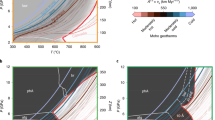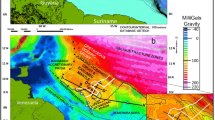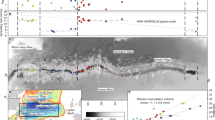Abstract
A 20-Myr record of creation of oceanic lithosphere is exposed along a segment of the central Mid-Atlantic Ridge on an uplifted sliver of lithosphere. The degree of melting of the mantle that is upwelling below the ridge, estimated from the chemistry of the exposed mantle rocks, as well as crustal thickness inferred from gravity measurements, show oscillations of ∼3–4 Myr superimposed on a longer-term steady increase with time. The time lag between oscillations of mantle melting and crustal thickness indicates that the mantle is upwelling at an average rate of ∼25 mm yr-1, but this appears to vary through time. Slow-spreading lithosphere seems to form through dynamic pulses of mantle upwelling and melting, leading not only to along-axis segmentation but also to across-axis structural variability. Also, the central Mid-Atlantic Ridge appears to have become steadily hotter over the past 20 Myr, possibly owing to north–south mantle flow.
This is a preview of subscription content, access via your institution
Access options
Subscribe to this journal
Receive 51 print issues and online access
$199.00 per year
only $3.90 per issue
Buy this article
- Purchase on Springer Link
- Instant access to full article PDF
Prices may be subject to local taxes which are calculated during checkout







Similar content being viewed by others
References
Macdonald, K. C. et al. A new view of the mid ocean ridge from the behaviour of ridge axis discontinuities. Nature 335, 217–225 (1988)
Lin, J., Purdy, G. M., Shouten, H., Sempere, J. C. & Zervas, C. Evidence from gravity data for focused magmatic accretion along the Mid-Atlantic Ridge. Nature 344, 627–632 (1990)
Phipps Morgan, J. & Parmentier, E. M. Crenulated seafloor: Evidence for spreading-rate dependent structure of mantle upwelling and melting beneath a mid-oceanic spreading center. Earth Planet. Sci. Lett. 129, 73–84 (1995)
Auzende, J. M. et al. Direct observation of a section through slow-spreading oceanic crust. Nature 337, 726–729 (1989)
Kastens, K. et al. The Vema transverse ridge (Central Atlantic). Mar. Geophys. Res. 20, 533–556 (1998)
Gasperini, L. et al. Time constraints on the emplacement of an uplifted sliver of lithosphere at the Vema transverse ridge (Central Atlantic). J. Conf. Abstr. 4, 757 (1999)
Cande, S. C., LaBreque, J. L. & Haxby, W. F. Plate kinematics of the south Atlantic, chron C34 to the present. J. Geophys. Res. 93, 13479–13492 (1988)
Dick, H. J. B., Fisher, R. L. & Bryan, W. B. Mineralogic variability of the uppermost mantle along mid ocean ridges. Earth Planet. Sci. Lett. 69, 88–106 (1984)
Michael, P. J. & Bonatti, E. Peridotite composition from the North Atlantic; regional and tectonic variations and implications for partial melting. Earth Planet. Sci. Lett. 73, 91–104 (1985)
Johnson, K. T. M., Dick, H. J. B. & Shimizu, N. Melting in the oceanic upper mantle: An ion microprobe study of diopsides in abyssal peridotites. J. Geophys. Res. 95, 2661–2678 (1990)
Jaques, A. L. & Green, D. H. Anhydrous melting of peridotite at 0-15 kb pressure and the genesis of tholeiitic basalts. Contrib. Mineral. Petrol. 73, 287–310 (1980)
Mysen, B. O. & Kushiro, I. Compositional variations of coexisting phases with degree of melting of peridotite in the upper mantle. Am. Mineral. 62, 843–865 (1977)
Hellebrand, E., Snow, J. E., Dick, H. J. B. & Hofmann, A. W. Coupled major and trace elements as indicators of the extent of melting in mid-ocean-ridge peridotites. Nature 410, 677–681 (2001)
Seyler, M. & Bonatti, E. Regional-scale melt-rock interaction in lherzolitic mantle in the Romanche fracture zone (Atlantic Ocean). Earth Planet. Sci. Lett. 146, 273–287 (1997)
Brunelli, D. Variazioni temporali nei processi di formazione di litosfera lungo le dorsali medio-oceaniche Thesis, Univ. Bologna (2001)
Forsyth, D. W. Crustal thickness and the average depth and degree of melting in fractional melting models of passive flow beneath mid-ocean ridges. J. Geophys. Res. 98, 16073–16079 (1993)
Sandwell, D. T. & Smith, W. H. F. Marine gravity anomaly from Geosat and ERS-1 satellite altimetry. J. Geophys. Res. 102, 10039–10054 (1997)
Li, J. & Sideris, M. G. Marine gravity and geoid determination by optimal combination of satellite altimetry and shipborne gravimetry data. J. Geodesy 71, 209–216 (1997)
Kuo, B. Y. & Forsyth, D. W. Gravity anomalies of the ridge-transform system in the South Atlantic between 31° and 34.5° S: Upwelling centers and variations in crustal thickness. Mar. Geophys. Res. 10, 205–232 (1988)
Louden, K. E., White, R. S., Potts, C. G. & Forsyth, D. W. Structure and seismotectonics of the Vema fracture zone, Atlantic Ocean. J. Geol. Soc. Lond. 143, 795–805 (1986)
Potts, C. G., White, R. S. & Louden, K. E. Crustal structure of Atlantic fracture zones: II, The Vema fracture zone and transverse ridge. Geophys. J. R. Astron. Soc. 86, 491–513 (1986)
Spiegelman, M. & Kenyon, P. M. The requirements for chemical disequilibrium during magma migration. Earth Planet. Sci. Lett. 109, 611–620 (1992)
Spiegelman, M. & Elliott, T. Consequences of melt transport for uranium series disequilibrium in young lavas. Earth Planet. Sci. Lett. 118, 1–20 (1993)
Lundstrom, C. C., Gill, J., Williams, Q. & Perfit, M. R. Mantle melting and basalt extraction by equilibrium porous flow. Science 270, 1958–1961 (1995)
Langmuir, C. H., Klein, E. M. & Plank, T. in (eds Phipps Morgan, J., Blackman, D. K. & Sinton, J. M.) 183–280 (Geophysical Monograph 71, American Geophysical Union, 1992)
Taylor, W. R. An experimental test of some geothermometer and geobarometer formulations for upper mantle peridotites with application to the thermobarometry of fertile lherzolite and garnet websterite. Neues Jb. Mineral. Abh. 172, 381–408 (1998)
Lasaga, A. C. in Advances in Physical Geochemistry Vol. 3 (ed. Saxena, S. K.) 81–114 (Springer, 1983)
Magde, L. S., Sparks, D. W. & Detrick, R. S. The relationship between buoyant mantle flow, melt migration, and gravity bull's eyes at the Mid-Atlantic Ridge between 33°N and 35°N. Earth Planet. Sci. Lett. 148, 59–67 (1997)
Magde, L. S., Barclay, A. H., Toomey, D. R., Detrick, R. S. & Collins, J. A. Crustal magma plumbing within a segment of the Mid Atlantic Ridge, 35° N. Earth Planet. Sci. Lett. 175, 55–67 (2000)
Scott, D. R. & Stevenson, D. J. Magma solitons. Geophys. Res. Lett. 11, 1161–1164 (1984)
Reid, I. & Jackson, H. R. Oceanic spreading rate and crustal thickness. Mar. Geophys. Res. 5, 165–172 (1981)
Phipps Morgan, J. & Forsyth, D. W. Three-dimensional flow and temperature perturbations due to a transform offset: Effects on oceanic crustal and upper mantle structure. J. Geophys. Res. 93, 2955–2966 (1988)
Blackman, D. K. & Forsyth, D. W. in (eds Phipps Morgan, J., Blackman, D. K. & Sinton, J. K.) 311–326 (Geophysical Monograph 71, American Geophysical Union, 1992)
Buck, W. R. & Su, W. Focused mantle upwelling below mid-ocean ridges due to feedback between viscosity and melting. Geophys. Res. Lett. 16, 641–644 (1989)
Scott, D. R. & Stevenson, D. J. A self-consistent model of melting, magma migration and buoyancy-driven circulation beneath mid-ocean ridges. J. Geophys. Res. 94, 2973–2988 (1989)
Sotin, C. J. & Parmentier, E. M. Dynamical consequences of compositional and thermal density stratification beneath spreading centers. Geophys. Res. Lett. 16, 835–838 (1989)
Pariso, J. E., Sempere, J. C. & Rommevaux, C. Temporal and spatial variations in crustal accretion along the Mid-Atlantic Ridge (29°-31°30′N) over the last 10 m.y.: Implications from a 3-D gravity study. J. Geophys. Res. 100, 17781–17794 (1995)
Tucholke, B. E. et al. Segmentation and crustal structure of the western Mid-Atlantic Ridge flank, 25°25′-27°10′N and 0-29 m.y. J. Geophys. Res. 102, 10203–10223 (1997)
Sparks, D. W., Parmentier, E. M. & Phipps Morgan, J. Three-dimensional convection beneath a segmented spreading center: Implications for along-axis variations in crustal thickness and gravity. J. Geophys. Res. 98, 21977–21995 (1993)
Hirth, G. & Kohlstedt, D. L. Water in the oceanic upper mantle: Implications for rheology, melt extraction and the evolution of the lithosphere. Earth Planet. Sci. Lett. 144, 93–108 (1996)
Braun, M. G., Hirth, G. & Parmentier, E. M. The effect of deep damp melting on mantle flow and melt generation beneath mid-ocean ridges. Earth Planet. Sci. Lett. 176, 339–356 (2000)
Choblet, G. & Parmentier, E. M. Mantle upwelling and melting beneath slow-spreading centers: Effects of variable rheology and melt productivity. Earth Planet. Sci. Lett. 184, 589–604 (2001)
Neumann, G. A. & Forsyth, D. W. The paradox of the axial profile: Isostatic compensation along the axis of the Mid-Atlantic Ridge? J. Geophys. Res. 98, 17891–17910 (1993)
Detrick, R. S., Needham, H. D. & Renard, V. Gravity anomalies and crustal thickness variations along the Mid-Atlantic Ridge between 33°N and 40°N. J. Geophys. Res. 100, 3767–3787 (1995)
Hooft, E. E. E., Detrick, R. S., Toomey, D. R., Collins, J. A. & Lin, J. Crustal thickness and structure along three contrasting spreading segments of the Mid-Atlantic Ridge, 33.5°-35°N. J. Geophys. Res. 105, 8205–8226 (2000)
Shen, Y. et al. Seismic evidence for a tilted mantle plume and north-south mantle flow beneath Iceland. Earth Planet. Sci. Lett. 197, 261–272 (2002)
Yang, X. & Fischer, K. M. Constraints on North Atlantic upper mantle anisotropy from S and SS phases. Geophys. Res. Lett. 21, 309–312 (1994)
Prince, R. A. & Forsyth, D. W. Horizontal extent of anomalously thin crust near the Vema fracture zone from the three-dimensional analysis of gravity anomalies. J. Geophys. Res. 93, 8051–8063 (1988)
Huang, M., Guan, Z., Zhai, G. & Ouyang, Y. On the compensation of systematics errors in marine gravity measurements. Mar. Geodesy 22, 183–194 (1999)
Bonatti, E. et al. Steady-state creation of crust-free lithosphere at cold spots in mid-ocean ridges. Geology 29, 979–982 (2001)
Acknowledgements
We thank A. Peyve and co-workers at the Geology Institute, Russian Academy of Science, and the captain and crew of the RV Akademic N. Strakhov for help with field work. We thank K. Kastens for providing cruise EW9305 gravity data; W. R. Buck and J. Karson for comments on the manuscript; and D.W. Forsyth for providing programs useful in processing gravity data. This work was supported by the Consiglio Nazionale Ricerche and the National Science Foundation.
Author information
Authors and Affiliations
Corresponding author
Ethics declarations
Competing interests
The authors declare that they have no competing financial interests.
Rights and permissions
About this article
Cite this article
Bonatti, E., Ligi, M., Brunelli, D. et al. Mantle thermal pulses below the Mid-Atlantic Ridge and temporal variations in the formation of oceanic lithosphere. Nature 423, 499–505 (2003). https://doi.org/10.1038/nature01594
Received:
Accepted:
Issue Date:
DOI: https://doi.org/10.1038/nature01594
This article is cited by
-
Unveiling the contourite depositional system in the Vema Fracture Zone (Central Atlantic)
Scientific Reports (2023)
-
The mantle temperature corrected gravimetric Moho using SGG-UGM-2 gravity data: An evidence of asymmetric distribution of thin and thick crust along the Central Indian Ridge (3°S–16°S)
Marine Geophysical Research (2022)
-
Generation and evolution of the oceanic lithosphere in the North Atlantic
La Rivista del Nuovo Cimento (2022)
-
Crustal structure and Moho topography of the southern part (18° S–25° S) of Central Indian Ridge using high-resolution EIGEN6C4 global gravity model data
Geo-Marine Letters (2021)
-
High H2O Content in Pyroxenes of Residual Mantle Peridotites at a Mid Atlantic Ridge Segment
Scientific Reports (2020)
Comments
By submitting a comment you agree to abide by our Terms and Community Guidelines. If you find something abusive or that does not comply with our terms or guidelines please flag it as inappropriate.



